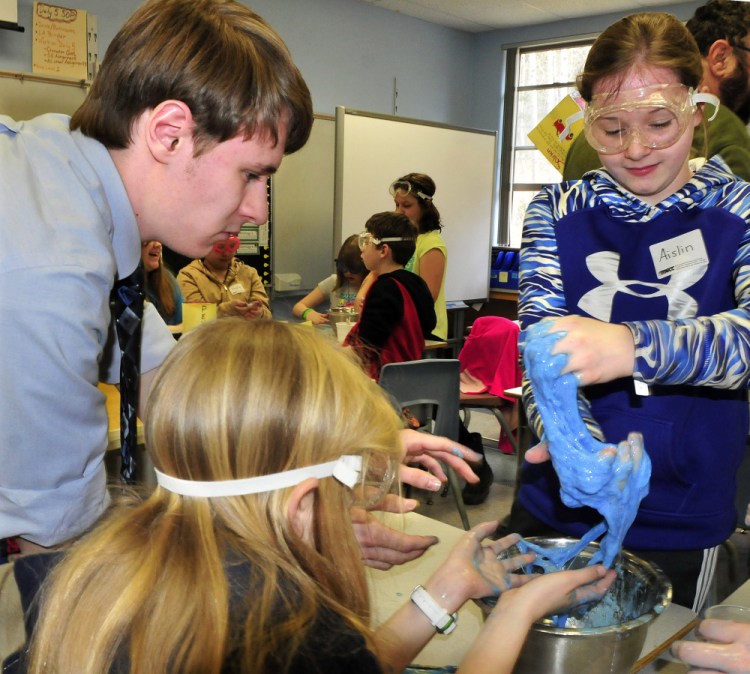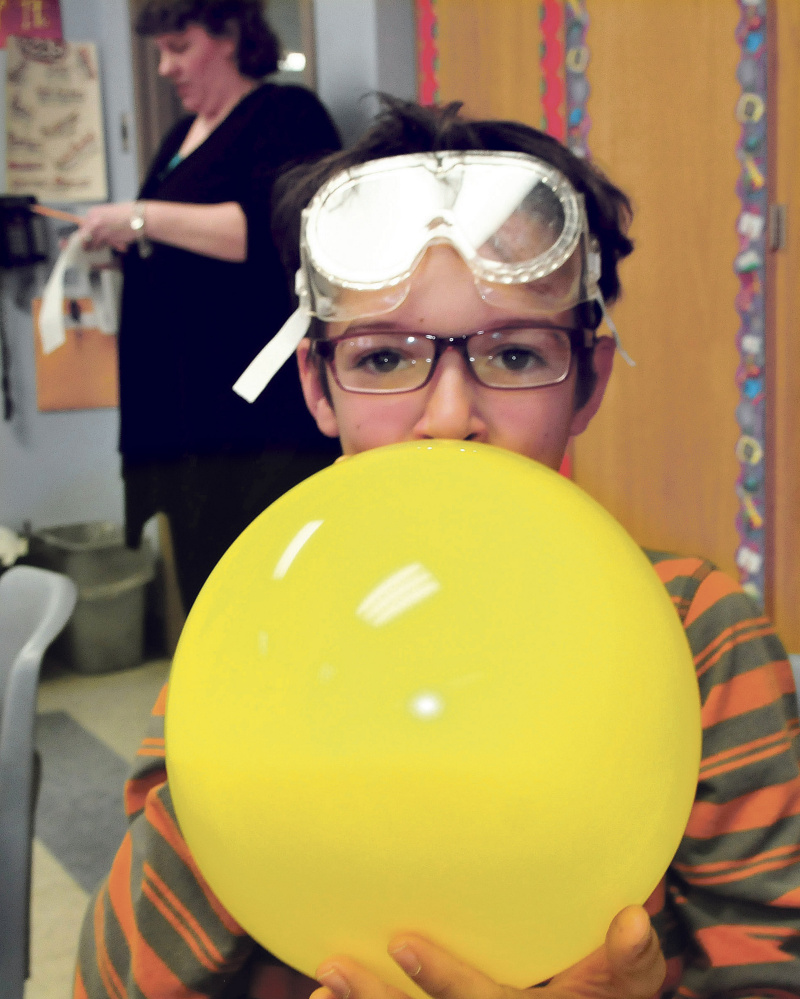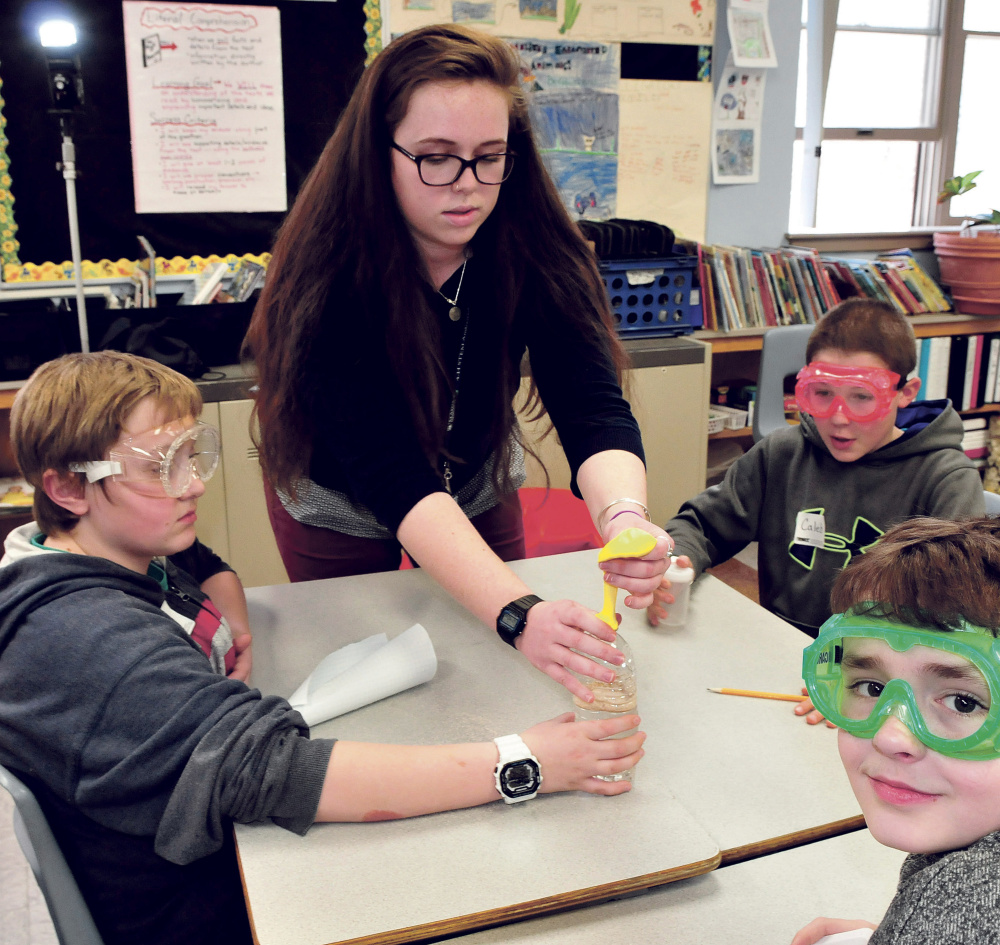FARMINGTON — Lynn Wells’ fifth-grade Cascade Brook School classroom has agreed to give up recess six times over the course of the spring semester to learn science. And judging by the high energy and giggles that filled the classroom during one of these sessions last week, the students didn’t seem the least bit concerned about missing recess with their friends.
“If we (could) do this every day, it would be really cool,” fifth-grader Meren Zeliger said. “It would definitely be worth giving up recess.”
The sessions are the result of a new collaboration between the University of Maine at Farmington, UMaine Cooperative Extension’s 4-H Youth Development Program and participating Regional School Unit 9 classrooms.
The program is called STEM Ambassadors, and the goal is to have UMF students majoring in education or a STEM-affiliated major go into RSU 9 classrooms to teach science, technology, engineering and mathematics lessons. The program is offered at other University of Maine campuses, but February marked the start of UMF’s inclusion in the community outreach program.
“We’re excited to bring it to this community,” David Allen, a 4-H Youth Development professional working on the STEM Ambassador program at UMF.
This semester four students from UMF professor Grace Eason’s science methods class have been paired up with two RSU 9 classrooms to conduct six of the hour-long sessions.
UMF education students Jacob Vining and Emily Gray, both juniors, have led two STEM sessions focusing on chemistry so far this semester in Wells’ classroom. Similarly, at Mt. Blue Middle School, Elizabeth Carnell and Sikwani Dana, both seniors, are teaching lessons focused on wind power and alternative energy solutions to Patty Veayo’s eighth-grade class.
The STEM ambassadors, through the 4-H program, are provided with kits including lesson plans, worksheets and materials needed for classroom activities for each lesson.
Wells said not only do her students love each lesson for the hands-on learning approach, but as an educator with a loaded curriculum and minimal time, Wells said the program is a “totally awesome” way to supplement science education at an elementary level.
“My class really likes science and I have talked to them a lot about the switch in curriculum and how eventually it’s going to be a lot of math and reading at the lower levels and not so much science and social studies,” Well said. “But (my students) say it’s their favorite thing to do and that if you take out science and social studies the school wouldn’t be as fun for them.”
The switch over in curriculum to focus on mathematics and reading at elementary levels is the result of a lack of money and time, RSU 9 Superintendent Tom Ward said. While science is still taught at the lower levels, it is only at a basic level, because the district wants students to have grasped the basic foundation of reading and mathematics before advancing in the school system, where science and social studies is taught at a more in depth level.
“We have greater supports for reading and math,” Ward said. “Those are the basic areas that we want to make sure kids have grasped.”
Ward said he wishes the district had money to provide greater resources for science and social studies instruction at a lower level, but that another obstacle to elementary science instruction is that teachers at that grade level often lack a background in the subject.
That’s why STEM Ambassadors is a great program for rural districts, Allen said.
“(In schools) resources are limited; time is limited. Teaching science is sometimes a barrier for people that don’t have a science background. We try to make it really easy and adaptable to different audiences. It’s hands-on. People that are teaching it can learn at the same time as the students,” Allen said.
In their March 17 session, Vining and Gray taught a lesson on reactions. The lesson plan included several hands-on activities in which the students donned goggles and curious minds as they mixed substances to see what the reaction would be.
Wells said the kit and lesson they taught her students went right in line with her curriculum for mixtures and solutions but cost nothing for the school. “Its a win-win,” she said.
Additionally, Wells said this is a way for the UMF students to enhance their teaching skills.
Gray, who said she would like to focus on teaching middle school when she graduates, said these STEM sessions are allowing her to practice her teaching methods.
“I’m using what I learned at UMF especially when it comes to classroom management and learning sequences, we now know how to start the class and keep them thinking,” Gray said.
Vining said he aspires to teach high school science, specifically chemistry. While he admits that he may lack the patience to teach an elementary grade level, he said the STEM lessons are a great way to introduce young students to science so that by the time they reach high school, they enjoy the subject.
“The problem with science at a secondary level is that most people have it in their heads that science is a boring and dull subject. Part of this STEM program is to introduce (students) to science as a fun exploratory concept,” Vining said.
Ward expressed interest in continuing the program in RSU 9 schools next year. Wells said she was already looking at getting her classroom involved in the collaboration for next year.
“I’ll want to do it every single year if I can,” she said.
Lauren Abbate — 861-9252
Twitter: @Lauren_M_Abbate
Send questions/comments to the editors.





Comments are no longer available on this story